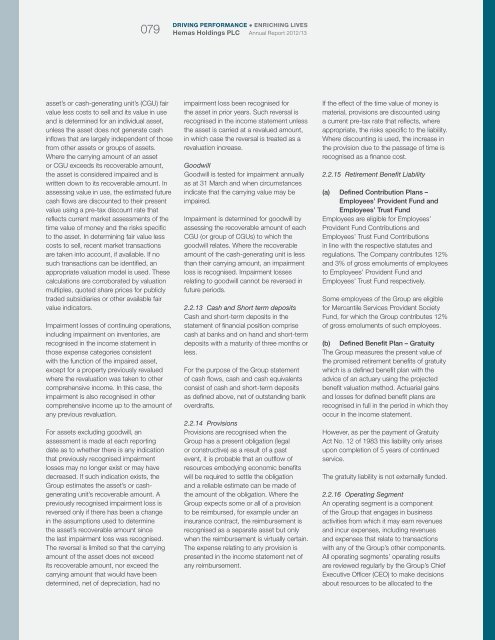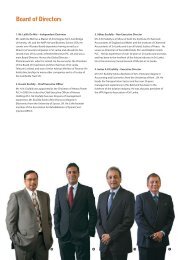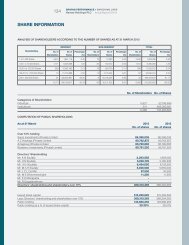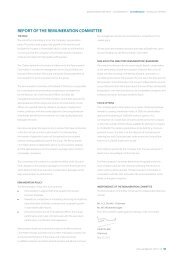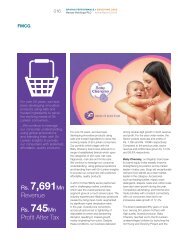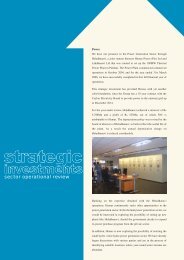Financial Statements - Hemas Holdings, Ltd
Financial Statements - Hemas Holdings, Ltd
Financial Statements - Hemas Holdings, Ltd
- No tags were found...
You also want an ePaper? Increase the reach of your titles
YUMPU automatically turns print PDFs into web optimized ePapers that Google loves.
DRIVING PERFORMANCE ● ENRICHING LIVES079 <strong>Hemas</strong> <strong>Holdings</strong> PLC Annual Report 2012/13asset’s or cash-generating unit’s (CGU) fairvalue less costs to sell and its value in useand is determined for an individual asset,unless the asset does not generate cashinflows that are largely independent of thosefrom other assets or groups of assets.Where the carrying amount of an assetor CGU exceeds its recoverable amount,the asset is considered impaired and iswritten down to its recoverable amount. Inassessing value in use, the estimated futurecash flows are discounted to their presentvalue using a pre-tax discount rate thatreflects current market assessments of thetime value of money and the risks specificto the asset. In determining fair value lesscosts to sell, recent market transactionsare taken into account, if available. If nosuch transactions can be identified, anappropriate valuation model is used. Thesecalculations are corroborated by valuationmultiples, quoted share prices for publiclytraded subsidiaries or other available fairvalue indicators.Impairment losses of continuing operations,including impairment on inventories, arerecognised in the income statement inthose expense categories consistentwith the function of the impaired asset,except for a property previously revaluedwhere the revaluation was taken to othercomprehensive income. In this case, theimpairment is also recognised in othercomprehensive income up to the amount ofany previous revaluation.For assets excluding goodwill, anassessment is made at each reportingdate as to whether there is any indicationthat previously recognised impairmentlosses may no longer exist or may havedecreased. If such indication exists, theGroup estimates the asset’s or cashgeneratingunit’s recoverable amount. Apreviously recognised impairment loss isreversed only if there has been a changein the assumptions used to determinethe asset’s recoverable amount sincethe last impairment loss was recognised.The reversal is limited so that the carryingamount of the asset does not exceedits recoverable amount, nor exceed thecarrying amount that would have beendetermined, net of depreciation, had noimpairment loss been recognised forthe asset in prior years. Such reversal isrecognised in the income statement unlessthe asset is carried at a revalued amount,in which case the reversal is treated as arevaluation increase.GoodwillGoodwill is tested for impairment annuallyas at 31 March and when circumstancesindicate that the carrying value may beimpaired.Impairment is determined for goodwill byassessing the recoverable amount of eachCGU (or group of CGUs) to which thegoodwill relates. Where the recoverableamount of the cash-generating unit is lessthan their carrying amount, an impairmentloss is recognised. Impairment lossesrelating to goodwill cannot be reversed infuture periods.2.2.13 Cash and Short term depositsCash and short-term deposits in thestatement of financial position comprisecash at banks and on hand and short-termdeposits with a maturity of three months orless.For the purpose of the Group statementof cash flows, cash and cash equivalentsconsist of cash and short-term depositsas defined above, net of outstanding bankoverdrafts.2.2.14 ProvisionsProvisions are recognised when theGroup has a present obligation (legalor constructive) as a result of a pastevent, it is probable that an outflow ofresources embodying economic benefitswill be required to settle the obligationand a reliable estimate can be made ofthe amount of the obligation. Where theGroup expects some or all of a provisionto be reimbursed, for example under aninsurance contract, the reimbursement isrecognised as a separate asset but onlywhen the reimbursement is virtually certain.The expense relating to any provision ispresented in the income statement net ofany reimbursement.If the effect of the time value of money ismaterial, provisions are discounted usinga current pre-tax rate that reflects, whereappropriate, the risks specific to the liability.Where discounting is used, the increase inthe provision due to the passage of time isrecognised as a finance cost.2.2.15 Retirement Benefit Liability(a) Defined Contribution Plans –Employees’ Provident Fund andEmployees’ Trust FundEmployees are eligible for Employees’Provident Fund Contributions andEmployees’ Trust Fund Contributionsin line with the respective statutes andregulations. The Company contributes 12%and 3% of gross emoluments of employeesto Employees’ Provident Fund andEmployees’ Trust Fund respectively.Some employees of the Group are eligiblefor Mercantile Services Provident SocietyFund, for which the Group contributes 12%of gross emoluments of such employees.(b) Defined Benefit Plan – GratuityThe Group measures the present value ofthe promised retirement benefits of gratuitywhich is a defined benefit plan with theadvice of an actuary using the projectedbenefit valuation method. Actuarial gainsand losses for defined benefit plans arerecognised in full in the period in which theyoccur in the income statement.However, as per the payment of GratuityAct No. 12 of 1983 this liability only arisesupon completion of 5 years of continuedservice.The gratuity liability is not externally funded.2.2.16 Operating SegmentAn operating segment is a componentof the Group that engages in businessactivities from which it may earn revenuesand incur expenses, including revenuesand expenses that relate to transactionswith any of the Group’s other components.All operating segments’ operating resultsare reviewed regularly by the Group’s ChiefExecutive Officer (CEO) to make decisionsabout resources to be allocated to the


